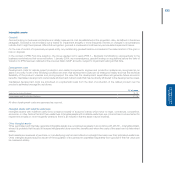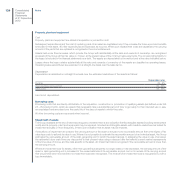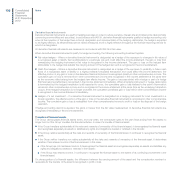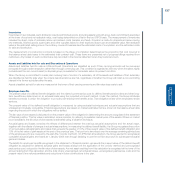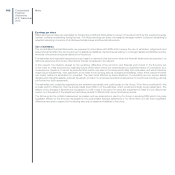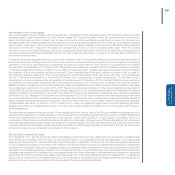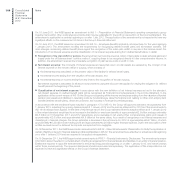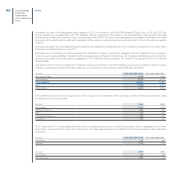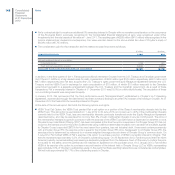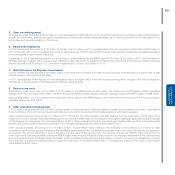Chrysler 2012 Annual Report Download - page 144
Download and view the complete annual report
Please find page 144 of the 2012 Chrysler annual report below. You can navigate through the pages in the report by either clicking on the pages listed below, or by using the keyword search tool below to find specific information within the annual report.
143
Consolidated
Financial Statements
at 31 December 2012
Accounting standards, amendments and interpretations applied since 1 January 2012
On 7 October 2010, the IASB issued amendments to IFRS 7 – Financial Instruments: Disclosures, adopted prospectively by the Group
from 1 January 2012. The amendments allow users of financial statements to improve their understanding of transfers (“derecognition”)
of financial assets, including an understanding of the possible effects of any risks that may remain with the entity that transferred the
assets. The amendments also require additional disclosures if a disproportionate amount of a transfer transaction is undertaken at the
end of a reporting period. The application of these amendments had no significant effect on the disclosures presented in this Annual
report nor on the measurement of the related items. For further details see Note 19 Current receivables and Other current assets-
Transfer of financial assets.
Accounting standards, amendments and interpretations effective from 1 January 2012 but not applicable to the Group
The following amendment, effective from 1 January 2012, relates to matters that were not applicable to the Group at the date of this
Annual Report, but may affect the accounting for future transactions or arrangements.
On 20 December 2010, the IASB issued a minor amendment to IAS 12 – Income Taxes which clarify the accounting for deferred
tax relating to investment properties measured at fair value. The amendment introduces the presumption that the carrying amount
of deferred taxes relating to investment properties measured at fair value under IAS 40 will be recovered through sale. As a result of
the amendments, SIC-21 Income Taxes – Recovery of Revalued Non-Depreciable Assets no longer applies. These amendments
are effective retrospectively for annual periods beginning on or after 1 January 2012.
Accounting standards and amendments not yet applicable and not early adopted by the Group
On 12 May 2011, the IASB issued IFRS 10 – Consolidated Financial Statements replacing SIC-12 – Consolidation: Special Purpose
Entities and parts of IAS 27 – Consolidated and Separate Financial Statements (subsequently reissued as IAS 27 - Separate Financial
Statements which addresses the accounting treatment of investments in separate financial statements). The new standard builds
on existing principles by identifying the concept of control as the determining factor in whether an entity should be included in the
consolidated financial statements of the parent company. The standard provides additional guidance to assist in the determination of
control where this is difficult to assess. The standard is effective retrospectively, at the latest for annual reporting periods beginning on
or after 1 January 2014. At the date of this Annual Report the Group is assessing any effects which may result from the adoption of the
standard whose effective date for the Group will be communicated in the interim report for the first quarter of 2013.
On 12 May 2011, the IASB issued IFRS 11 – Joint Arrangements superseding IAS 31 – Interests in Joint Ventures and SIC-13 – Jointly
Controlled Entities: Non-Monetary Contributions by Venturers. The new standard provides the criteria for identifying joint arrangements
by focusing on the rights and obligations of the arrangement, rather than its legal form and requires a single method to account for
interests in jointly-controlled entities, the equity method. The standard is effective retrospectively, at the latest for annual reporting
periods beginning on or after 1 January 2014. Following the issue of the new standard, IAS 28 – Investments in Associates has been
amended to include accounting for investments in jointly-controlled entities in its scope of application (from the effective date of the
standard). At the date of this Annual Report, the Group is assessing any effects which may result from the adoption of the standard
whose effective date for the Group will be communicated in the interim report for the first quarter of 2013.
On 12 May 2011, the IASB issued IFRS 12 – Disclosure of Interests in Other Entities, a new and comprehensive standard on disclosure
requirements for all forms of interests in other entities, including subsidiaries, joint arrangements, associates, special purpose vehicles
and other unconsolidated vehicles. The standard is effective at the latest for annual reporting periods beginning on or after 1 January
2014. At the date of this Annual Report, the Group is assessing any effects which may result from the adoption of the standard whose
effective date for the Group will be communicated in the interim report for the first quarter of 2013.
On 12 May 2011, the IASB issued IFRS 13 – Fair Value Measurement, clarifying the determination of the fair value for the purpose of
the financial statements and applying to all IFRSs permitting or requiring a fair value measurement or the presentation of disclosures
based on fair value. The standard is effective prospectively from 1 January 2013. The application of this new standard is not expected
to have any significant effects on the Group’s financial statement.


